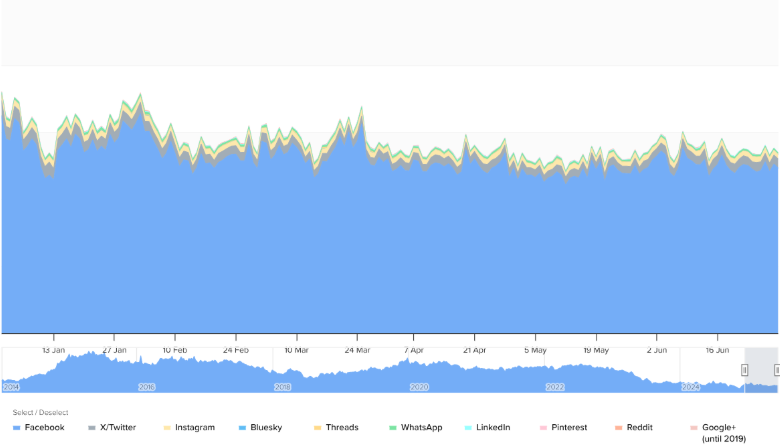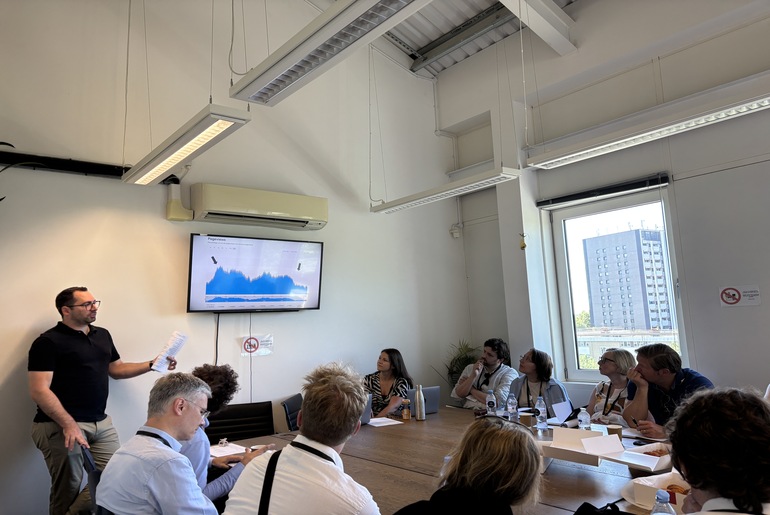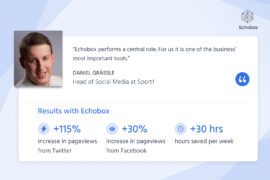It was a pleasure to welcome the heads of Madsack, Funke, Ippen and many more of Germany’s top publishers when they descended on Echobox HQ recently.
Part of a city-wide study tour organized by Annette Milz, founder and CEO at Chefrunde, the conversations were wide-ranging: from the role of different content types and how they perform, to the channels that are still driving meaningful traffic in 2025; shifts in audience behaviour, editorial strategy, AI in the newsroom, and how publishers are adapting to the fast-changing media landscape.
Here are a few takeaways from their visit.
1. Image-link shares
As you might expect, driving traffic from social media is still a priority for news publishers. “How” was an important topic of discussion.
The short answer, backed up by study after study, is image-link posts. Publishers who want to reassert some control over their Facebook performance and increase traffic need to be posting image-link shares. This isn’t even one strategy among many. Right now, including image-link shares in your share mix is the only way to increase traffic.
Importantly though, this isn’t to say that all posts should be image-link shares — that would be too simple. Instead, what Facebook’s algorithms seem to prioritize is a mix of share types — link and image-link and perhaps video, too. determining the optimal ratio of share types for you will take lengthy and detailed experimentation. Or intelligent AI-powered automation.
2. Facebook still dominates
Another important question that came up is where publishers should be looking for traffic. Which platforms should they be focusing on? Image-link shares are so important for traffic because Facebook is still so important for traffic.
A look at our Social Media Index confirms this.

Relative to all other social networks, Facebook (the light blue colour that dominates the graph) is still the biggest source of referral traffic, by far.
That’s not to say that other social networks are unimportant, however. In fact they’ve never been more important. We’re always delighted to hear how publishers are producing substantial traffic from different sources, from established platforms like LinkedIn to newer ones like Threads, Bluesky or WhatsApp. Each publisher’s unique audience is best served in different ways and on different platforms.
But speaking more broadly, growing and sustaining traffic involves a holistic approach to content distribution.
One theme that cropped up was the merits of meeting younger readers where they are, on platforms that traditionally don’t generate traffic. Should publishers put all of their resources towards traffic, or potentially future-proof themselves with a focus on capturing readers early? That, of course, depends on the resources available to a publisher and their own distinct business goals. That said, given the capricious nature of social media algorithms, we would always advise publishers to spread their content as far and wide as possible. This helps insure against changes to individual algorithms or the whims of individual C-suites. Of course, with a social media solution powered by AI-automation, this is easier than ever.
Traffic, though, doesn’t stop with social media. Newsletters have become an essential weapon in publishers’ armories, as a direct and (relatively) unmediated way of getting content in front of subscribers. Coupled with the potential for deep and effective personalization and segmentation, newsletters are a key element in any publishers’ strategy.
3. How to capture attention
A particularly engaging part of the conversation centered around how publishers craft content for social sharing — specifically the strategy behind captions. Should they be short and to the point? Should they be click-baity to drive curiosity? Or should they carry more context to build trust with the audience?
From our experience at Echobox, shorter share messages tend to perform better — just enough information to pique interest and encourage a click-through. However, as the group rightly noted, there’s no one-size-fits-all solution. Caption style often depends entirely on editorial goals and brand identity. Some publishers lean into curiosity-driven headlines to drive engagement, while others prefer to avoid clickbait in favor of clarity and credibility. The diversity in approaches highlighted the nuanced balance between engagement and integrity that every newsroom must navigate.
4. Adapting to the new digital landscape
Ultimately, our rich discussions painted a clear picture: adapting to today’s media landscape isn’t about one magic bullet. It’s about a multi-faceted approach.
From leveraging image-link shares to boost Facebook traffic, to embracing a holistic distribution strategy across diverse platforms, and strengthening newsletters for direct audience connection, publishers are actively innovating. But the ever-growing list of platforms and formats that publishers are now having to engage with presents its own unique problems. Time has never been at such a premium for social and editorial teams already stretched thin.
Combining AI-automation with unique human know-how not only increases performance on social platforms, but frees up teams to dedicate themselves to more ambitious tasks that really generate value.



